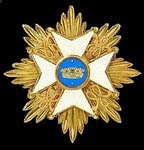I return briefly to my beloved French flags. Kronoskaf and the website Nec Pluribus Impar say that the Volontaires de Hainaut carried the flags of the Arquebusiers de Grassin, which I cannot find confirmed anywhere else, but as the thought pleases me I shall go along with it, as it means the flags can be used both in the WAS and SYW.
The Arquebusiers de Grassin were first raised January 1744. At first they consisted of 1300 men in total, including 900 fusiliers in nine companies, 100 grenadiers in two companies and 300 cavalry in six companies. An additional 200 cavalry were raised in 1745 but in 1748 they were progressively reduced to a total of only 340 men by December that year. In August 1749 they were incorporated into the Volontaires de Flandres.
Their somewhat exotic uniform is well known.
They saw much action in the War of Austrian Succession. At Fontenoy in May 1745 they were thrown into the Wood of Bary. At the battle of Rocoux along with the Fusiliers de la Morlière (with whom they often fought) they spearheaded the attack on the village of Hans, contributing to the withdrawal of the enemy left wing followed by the retreat of much of the rest of the enemy army. They were opposed by Pandours and Croats during much of the action. At the end of the action they attacked the Dutch artillery which withdrew, although the Grassins captured 22 guns and more than 60 artillery carts with teams. They also attacked and attempted to destroy bridges over the Meuse which the enemy was using in its retreat. At the battle of Lauffeld they were similarly employed on the right of the army but overthrown by the British cavalry. They were also at the siege of Huy in August 1746.
The Volontaires de Hainaut were raised in April 1757 by splitting the Volontaires de Flandres in two. The unit consisted of six companies of 70 men each, including 30 dragoons. In February 1758 it consisted of eight companies of 75 men each - 40 fusiliers and 35 dragoons. The unit became the Legion de Hainaut in December 1762, the Legion de Lorraine in 1768 and was disbanded in 1776.
The Osprey on the light troops of Louis XV has a useful summary of the unit's activities in the Seven Years War (and Kronoskaf has a more detailed account). The Volontaires de Hainaut saw much action in the Seven Years War. They first saw action at the battle of Hastenbeck in 1757, then took part in the surprise attack on Harbourg, where they captured hundreds of enemy soldiers and several flags but the unit was captured after the surrender of the garrison of Minden in March 1758, following a stubborn resistance. It was re-raised by a new commander, Thomas-Auguste de Grandmaison, who was the author of La Petite Guerre, a treatise on partisan and light troop warfare. Having been sent to Germany the unit fought at Bork, Minden, Mardorf, Nordecken and Laughaus in 1758, rescued Bercheny's hussars in a fight in July 1760 and then captured Minden in August. Its most famous feat was its capture of the infantry of G'shray's Prussian Frei Korps at Nordhausen in August 1761.
And this is the fusilier uniform in 1757:
And these were the later SYW flags of the Volontaires de Hainaut:






















